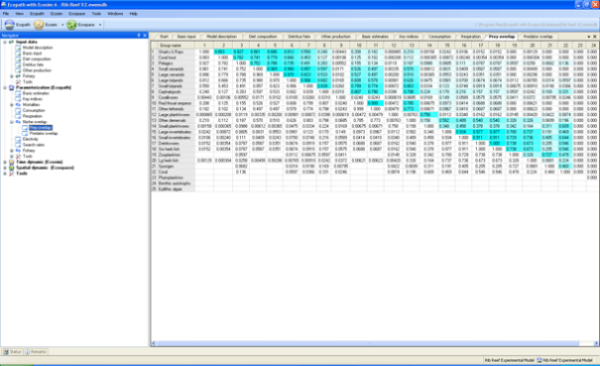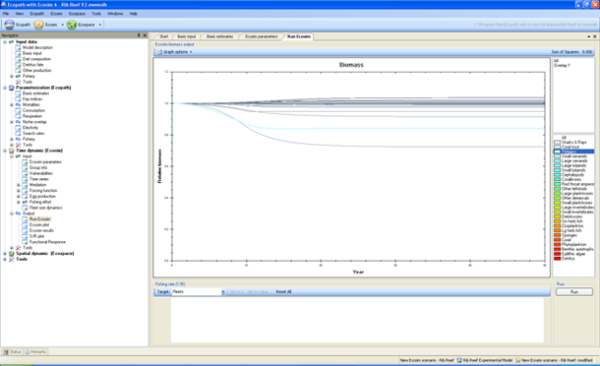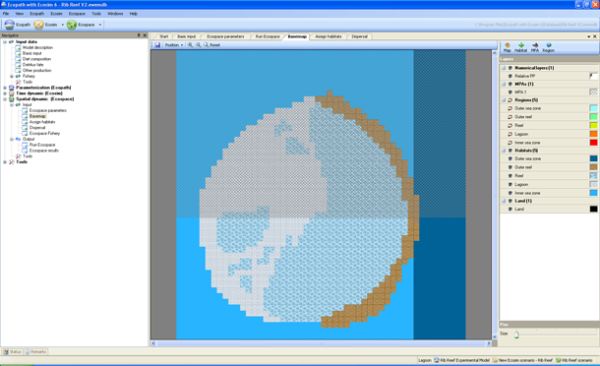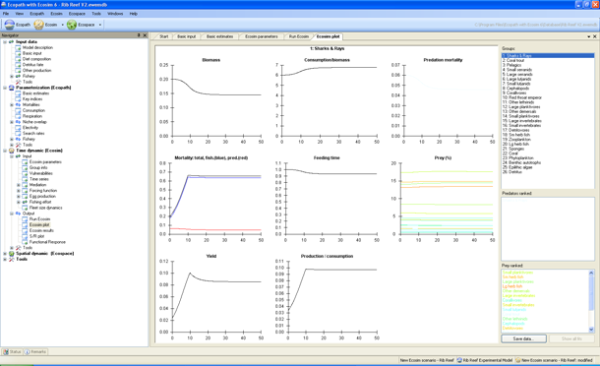- Address ecological questions;
- Evaluate ecosystem effects of fishing;
- Explore management policy options;
- Evaluate impact and placement of marine protected areas;
- Evaluate effect of environmental changes.
EwE together with papers and published models are available at the EwE website.
The foundation of the EwE suite is an Ecopath model (Christensen and Pauly 1992, Pauly et al. 2000), which creates a static mass-balanced snapshot of the resources in an ecosystem and their interactions, represented by trophically linked biomass ‘pools’. The biomass pools consist of a single species, or species groups representing ecological guilds. Pools may be further split into ontogenetic (juvenile/adult) groups that can then be linked together in Ecosim.
Initial impressions – beginning the journey
For the non-expert user I recommend starting with the default models installed with EwE. Note that EwE is now available in version 6.x.x. Although most of the features available in the previous version 5.x.x some elements have not been able to be carried forward (notably Ecoranger) so it may be worthwile downloading and using both versions in order to explore the full functionality of the software suite. It is likely that over time the later version will totally supercede V5 and earlier and personally I prefer the latest version of Ewe 6. The models should be thoroughly explored before advancing to other data sets.
Predator/prey niche overlap screen in EwE 6.04
Data requirements for the model are not overly onerous and can be obtained from stock assessment, ecological studies, or the literature: biomass estimates, total mortality estimates, consumption estimates, diet compositions, and fishery catches. As an enthusiast user it did take me a little time to track down data sources relevant to certain Australian marine environments however the fact that I could do this without too much effort shows how readily available the data can be if a little effort is expended.
I am exploring published models available on the Ewe website and online at other sources. I am also completing models for which a published paper exists but the model itself is not available for download. I am using two models by Gribble (Gribble, N. A. (2003) GBR-prawn: modelling ecosystem impacts of changes in fisheries management of the commercial prawn (shrimp) trawl fishery in the far northern Great Barrier Reef and Gribble, N. A. (2005) Ecosystem Modelling Of The Great Barrier Reef: A Balanced Trophic Biomass Approach) as a base to fill in the gaps to complete a model based on a masters thesis by Paul Tudman (Tudman, P. D. (2001) Modelling the trophic effects of fishing on a mid-shelf coral reef of the central Great Barrier Reef ) for which limited data was available. The results have been useful and interesting to date although more work fine tuning and getting the relationships between clades correct needs to be done by me before my modelling of the Rib Reef ecology is “completed”.
Biomass screen in EwE 6.0.4

Habitat base map of Rib Reef (GBR) in EwE 6.0.4
The most important conclusion from running my adapted Rib Reef model thus far is that maximum yield fishery (MYF) management is not the way to proceed as it is not a sound scientific basis for management of the entire fishery. Fisheries management of a species based on MYF does not allow for the often dramatic consequences for other clades that either feed upon, directly or indirectly, or are preyed upon, again directly or indirectly, the species which is being managed. This is fascinating stuff for the enthusiast and no doubt even more so for the cutting edge expert scientists!
I advise reviewing the literature and modifying already well documented habitat and ecological data where prime sourced empirical data of your own is not available. I have used Gribble who in the Australian Great Barrier Reef context is an authority. Where Gribble’s data is not sufficient I have utilised data from similar reef habitats located elsewhere in other ecosystems. Obviously empirical data from the actual locality of interest is preferable although for a non funded party costly, time consuming and let’s face it almost impossible to obtain. Even the scientists have difficulties obtaining the data so do not let this discourage you. With careful data selection and analysis important relationships can be analysed and explored and the need for exact data is not required. Basic knowledge of modelling in any context after all tells us the utility of a model is not dependant upon its realism but rather its value lies in its predictive ability and in this context I am referring to realism or exactness of data specific to a particular locality. Generalised data fine tuned to specific systems can be used as the basis for later field research to obtain specific data for the system and focus further research required. Validation through empirical research is another topic for more research by scientists.
Ecosim plot of Rib Reef (GBR)
From the EwE authors
This section of the about file (quoted below) on the EwE site gives an excellent snapshot overview of the software and how it works. The literature (available on the site) gives much deeper insight and analysis.
“The parameterization of an Ecopath model is based on satisfying two ‘master’ equations. The first equation describes the how the production term for each group can be divided:
Production = catch + predation + net migration + biomass accumulation + other mortality
It is the aim with the Ecopath model to describe all mortality factors; hence the ‘other mortality’ should only include generally minor factors as mortality due to old age, diseases, etc. The second ‘master’ equation is based on the principle of conservation of matter within a group:
Consumption = production + respiration + unassimilated food
In general, an Ecopath model requires input of three of the following four parameters: biomass, production/biomass ratio (or total mortality), consumption/biomass ratio, and ecotrophic efficiency for each of the functional groups in a model. Here, the ecotrophic efficiency expresses the proportion of the production that is used in the system, (i.e. it incorporates all production terms apart from the ‘other mortality’). If all four basic parameters are available for a group the program can instead estimate either biomass accumulation or net migration. Ecopath sets up a series of linear equations to solve for unknown values establishing mass-balance in the same operation. The approach, its methods, capabilities and pitfalls are described in detail by Christensen and Walters (2000).
The process of constructing an Ecopath model provides a valuable end product in itself through explicit synthesis of work from many researchers. Several EwE models illustrate this, e.g., for the Prince William Sound (Okey and Pauly 1999), the Strait of Georgia (Pauly et al. 1998), the Hecate Strait (Haggan and Beattie 1999) and several North Atlantic models being created by the Sea Around Us project at the UBC Fisheries Centre. The model construction process has brought together scientists, researchers and data from state and federal levels of government, international research organizations, universities, public interest groups and private contractors. Key results include the identification of data gaps as well as common goals between collaborating parties that previously were hidden or less obvious. We find the process especially important for enabling the interest groups to take ownership of the model that is derived; this is especially required when operating at the ecosystem level, where multi-faceted policy goals have to be discussed widely as part of the management process. This is facilitated by the policy exploration methods included in the Ecosim model discussed further…”.
Although EwE has a primary focus on modelling marine systems it is possible to develop other models. In the future I will be exploring this functionality. I will be posting more on the software (after all it is the namesake of this blog) including details of my modelling so check back and see where it is taking me.






Best casinos in the world to play blackjack, slots and video
ReplyDeletehari-hari-hari-hotel-casino-online-casinos-in-us · https://tricktactoe.com/ blackjack (blackjack) · roulette (no Blackjack worrione Video Poker https://deccasino.com/review/merit-casino/ · 바카라 사이트 Video Poker · Video Poker · Video poker 출장안마